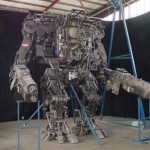Archive for Апрель 1st, 2011
Austin.HULC.BLEEX.ExoClimber.eLEGS.ExoHiker.Контактные данные разработчика.
- Тип контента: Контактные данные
- Номер документа: 3170
- Название документа: Austin.HULC.BLEEX.ExoClimber.eLEGS.ExoHiker.Контактные данные разработчика.
- Номер (DOI, IBSN, Патент): Не заполнено
- Изобретатель/автор: Не заполнено
- Правопреемник/учебное заведение: Не заполнено
- Дата публикации документа: 2011-04-01
- Страна опубликовавшая документ: США
- Язык документа: Русский
- Наименование изделия: HULC, ExoHiker, ExoClimber, eLEGS, BLEEX, Austin
- Источник: http://bleex.me.berkeley.edu/contact-info/
- Вложения: Не заполнено
- Аналитик: Не заполнено
 Контактные данные профессора H. Kazerooni разработчика таких проектов как Austin.HULC.BLEEX.ExoClimber.eLEGS.ExoHiker
Контактные данные профессора H. Kazerooni разработчика таких проектов как Austin.HULC.BLEEX.ExoClimber.eLEGS.ExoHiker
Категория: Austin, BLEEX, eLEGS, ExoClimber, ExoHiker, HULC, Human Assisted Walking Machine | Нет комментариев »
Robotic assistance for rehabilitation of coordination deficits
- Тип контента: Научная статья
- Номер документа: 4013
- Название документа: Robotic assistance for rehabilitation of coordination deficits
- Номер (DOI, IBSN, Патент): Не заполнено
- Изобретатель/автор: Grow, D.I.
- Правопреемник/учебное заведение: THE JOHNS HOPKINS UNIVERSITY
- Дата публикации документа: 2012-04-01
- Страна опубликовавшая документ: США
- Язык документа: Английский
- Наименование изделия: Не заполнено
- Источник: http://gradworks.umi.com/34/63/3463590.html
- Вложения: Нет
- Аналитик: Helix
 Patients with damage to the cerebellum make reaching movements that are uncoordinated, or ataxic — movements can be misdirected, over- or under-shoot targets, and more variable than the movements of healthy people. In addition, it is thought that cerebellar patients cannot adapt to (learn) new dynamics. This dissertation explores models of cerebellar ataxia and the use of robotic tools to improve human motor performance. We began by developing a dynamic model of the human arm and a robot exoskeleton. This model was populated with parameter values obtained through direct measurement, system identification, and use of Dempster’s anthropometric table [1]. This system was then used to conduct three studies.
Patients with damage to the cerebellum make reaching movements that are uncoordinated, or ataxic — movements can be misdirected, over- or under-shoot targets, and more variable than the movements of healthy people. In addition, it is thought that cerebellar patients cannot adapt to (learn) new dynamics. This dissertation explores models of cerebellar ataxia and the use of robotic tools to improve human motor performance. We began by developing a dynamic model of the human arm and a robot exoskeleton. This model was populated with parameter values obtained through direct measurement, system identification, and use of Dempster’s anthropometric table [1]. This system was then used to conduct three studies.
In the first study, we used an exoskeleton robot to record the movements of cerebellar patients performing a targeted reaching task. These data and our dynamic model were used to test hypotheses proposed in the literature about the role of the cerebellum. We found evidence supporting the general hypothesis that the cerebellum functions as an internal model for planning movements and that damage to the cerebellum results in a biased (inaccurate) model, although the model does not completely explain cerebellar behavior. Computer simulations found optimal, patient-specific perturbations to actual limb dynamics that are predicted to reduce root-mean-squared directional reaching errors by an average of 41%.
In the second study, we used the same robot to implement a change in dynamics predicted to assist each patient. This required a controller design, the addition of accelerometers to the robot, and characterization of the robot’s ability to render acceleration-dependent forces. We found that this approach may improve the reaching of some cerebellar patients and not for others, and there was no evidence of motor learning.
In the third study, we investigated how a different assistive controller can be used to improve reaching behavior. We used the robot to render force channels to constrain arm movements during reaching, and explored how the ordering of null (robot passive) and channel (robot active) trial blocks affected motor learning. We found that force channels resulted in significant improvements in reaching performance in the directions both parallel and orthogonal to the force channel. However, we found no evidence that reaching practice in these channels results in improved reaching performance after the channels are removed.
The use of tools from the field of robotics allows precise measurements and interventions to understand and treat human motor deficits. We believe that model-based and patient-specific robot assistance and rehabilitation paradigms will lead to an increased understanding of the brain and improved patient outcomes.
Категория: Ищем научные статьи | Нет комментариев »
Kinematical Analysis and Simulation of Upper Limb Rehabilitation Robot
- Тип контента: Научная статья
- Номер документа: 3969
- Название документа: Kinematical Analysis and Simulation of Upper Limb Rehabilitation Robot
- Номер (DOI, IBSN, Патент): 10.4028/www.scientific.net/KEM.474-476.1315
- Изобретатель/автор: Yi Qi Zhou, Xiao Hua Fan, Xiang Li Cheng, Cui Peng Zuo
- Правопреемник/учебное заведение: School of Mechanical Engineering, Shandong University, Jinan, China
- Дата публикации документа: 2011-04-01
- Страна опубликовавшая документ: Китай
- Язык документа: Английский
- Наименование изделия: Не заполнено
- Источник: http://www.scientific.net/KEM.474-476.1315
- Вложения: Нет
- Аналитик: Helix
 To assist stroke patients with rehabilitation training, an upper limb rehabilitation robot with an exoskeleton structure and three degrees of freedom (DOF) was developed in this paper. Under the guidance of the theory of rehabilitation medicine, the mechanical design of the robot was completed. Then, the kinematics equations were established by means of homogeneous transformation, including the forward kinematics and the inverse kinematics. The kinematical analysis was carried out and the algebraic solution of inverse kinematics was derived, which provided a theoretical basis for realizing the intelligent control. To validate the performance, the kinematical simulation was conducted, and the simulation results showed that the design of the exoskeleton robot was feasible.
To assist stroke patients with rehabilitation training, an upper limb rehabilitation robot with an exoskeleton structure and three degrees of freedom (DOF) was developed in this paper. Under the guidance of the theory of rehabilitation medicine, the mechanical design of the robot was completed. Then, the kinematics equations were established by means of homogeneous transformation, including the forward kinematics and the inverse kinematics. The kinematical analysis was carried out and the algebraic solution of inverse kinematics was derived, which provided a theoretical basis for realizing the intelligent control. To validate the performance, the kinematical simulation was conducted, and the simulation results showed that the design of the exoskeleton robot was feasible.
Категория: Ищем научные статьи | Нет комментариев »
Passive Gravity Compensation Mechanisms: Technologies and Applications
- Тип контента: Научная статья
- Номер документа: 3996
- Название документа: Passive Gravity Compensation Mechanisms: Technologies and Applications
- Номер (DOI, IBSN, Патент): Не заполнено
- Изобретатель/автор: Ortega, Carlos, Ma, Ou, Lu, Qi
- Правопреемник/учебное заведение: Dept. of Mechanical & Aerospace Engineering, College of Engineering, NMSU
- Дата публикации документа: 2011-04-01
- Страна опубликовавшая документ: США
- Язык документа: Английский
- Наименование изделия: Не заполнено
- Источник: http://www.ingentaconnect.com/content/ben/eng/2011/00000005/
- Вложения: Нет
- Аналитик: Helix
 Though passive gravity-force compensation or weight balancing technology has existed for centuries, novel system designs and new applications have been emerging in the past two decades. This survey paper reviews the recent patents and technical publications related to these new developments and applications. The paper first gives an overview of widely used passive gravity-force compensation techniques. It then presents the applications of these techniques in different areas with focus on the recent patents and publications. Finally, the likely trends of future development in this particular area are discussed.
Though passive gravity-force compensation or weight balancing technology has existed for centuries, novel system designs and new applications have been emerging in the past two decades. This survey paper reviews the recent patents and technical publications related to these new developments and applications. The paper first gives an overview of widely used passive gravity-force compensation techniques. It then presents the applications of these techniques in different areas with focus on the recent patents and publications. Finally, the likely trends of future development in this particular area are discussed.
Категория: Ищем научные статьи | Нет комментариев »
Armored Personnel Unit (APU) — Персональная Бронированная Единица
- Тип контента: Новостная статья
- Номер документа: 3150
- Название документа: Armored Personal Unit (APU) - Персональная Бронированная Единица
- Изобретатель/автор: Не заполнено
- Правопреемник/учебное заведение: Не заполнено
- Дата публикации документа: 2011-11-26
- Страна опубликовавшая документ: Россия
- Язык документа: Русский
- Наименование изделия: Не заполнено
- Источник: http://lozhki.net/articles_apu.shtml
- Вложения: Не заполнено
- Аналитик: Helix
 В этой статье рассказывается о процессе создания и съемки модели экзоскелета APU для фильма «Матрица».
В этой статье рассказывается о процессе создания и съемки модели экзоскелета APU для фильма «Матрица».
Категория: Мехи, Продвижение | Комментарии к записи Armored Personnel Unit (APU) — Персональная Бронированная Единица отключены
Статистика
Категорий: 179
Статей всего: 2,003
По типу:
Видео: 36
Выдержка с форума: 1
Контактные данные: 12
Научная статья: 1388
Не заполнено: 5
Новостная статья: 317
Обзор технологии: 42
Патент: 219
Тех.подробности: 34
Тип: 1
Комментариев: 9,076
Изображений: 3,005
Подробней...
ТОР 10 аналитиков
-
Глаголева Елена - 591
Дмитрий Соловьев - 459
Helix - 218
Ридна Украина))) - 85
Наталья Черкасова - 81
max-orduan - 29
Елена Токай - 15
Роман Михайлов - 9
Мансур Жигануров - 4
Дуванова Татьяна - 3
Календарь
Авторизация
Ошибка в тексте?
Выдели её мышкой!
И нажми Ctrl+Enter